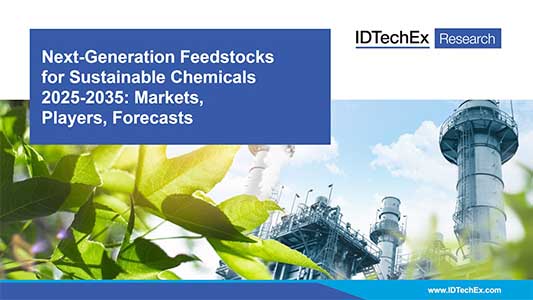As global pressure mounts to reduce carbon emissions and phase out fossil-based resources, next-generation chemical feedstocks are emerging as a key solution. Derived from renewable and waste sources, these innovative feedstocks offer a sustainable pathway to green chemical production. IDTechEx’s latest report, “Next-Generation Feedstocks for Sustainable Chemicals 2025-2035: Markets, Players, Forecasts“, delivers a deep dive into cutting-edge innovations, commercial developments, and market dynamics reshaping the future of chemical production.
How can waste become the future of sustainable chemicals?
Unlike first-generation bio-based chemicals produced from sugar crops, next-generation feedstocks are sourced from renewable, non-food materials. This includes lignocellulosic biomass (like agricultural residues and wood), algae, municipal solid waste, plastic waste, and even captured carbon dioxide. These feedstocks not only reduce reliance on petrochemicals but also significantly lower scope 3 emissions across the value chain by providing renewable sources of carbon. As many of these inputs are by-products from other sectors, they support a circular bioeconomy, turning waste into high-value green chemicals, specialty materials, and sustainable polymers.

Renewable sources of carbon: next-generation feedstocks and chemical product applications. Source: IDTechEx
How fast is sustainable chemical production growing?
Sustainable chemical production has seen a slower start than some expected, but momentum is building. Thanks in part to increasing regulatory support and corporate sustainability goals, many new facilities are in the pipeline. Global annual production capacity for chemicals from next-gen feedstocks is projected to grow at a 16% CAGR between 2025 and 2035, reaching over 11 million tonnes by 2035. Major industry players are already investing in sustainable feedstock technologies.
Dow Chemical, for instance, is supporting projects such as Xycle’s planned facility in Rotterdam, which will process 21 kT of plastic waste annually into valuable chemical products. Dow’s investment in Xycle is part of a broad portfolio of technologies to transform plastic waste and other forms of alternative feedstocks into 3 million tonnes of circular and renewable solutions annually. Another example is BASF, which established a long-term partnership with Encina in 2024. Encina will supply sustainable benzene derived from end-of-life plastics via chemical recycling. This IDTechEx report explores various investments and projects worldwide, highlighting key trends that will shape the future of chemical production and advancement towards a circular bioeconomy.
Barriers to overcome: Cost and complexity
Despite their promise, next-generation feedstocks still face economic and technical hurdles. Extraction and processing costs for chemicals produced from next-generation feedstocks are often higher than conventional fossil-based production due to the requirement of several pretreatment steps. Market adoption is also strongly influenced by crude oil prices, which could be impacted by US tariffs.
However, advancements in processing technologies are helping to close the gap. Companies such as Sonichem and Lixea are in the process of commercializing advanced lignin extraction technologies, including ultrasonic cavitation and ionic liquid processes. These will unlock higher-value, odor-free lignin with applications beyond burning the lignin for energy. Meanwhile, pioneers such as Anellotech and BioBTX are making headway in BTX (benzene, toluene, xylene) production from municipal waste, paving the way for truly sustainable aromatics. IDTechEx’s report provides an in-depth look at these technical advancements and their commercial viability.
A catalyst for industry transformation
Next-generation feedstocks represent a fundamental shift in how chemicals are made. They are poised to revolutionize the chemical industry through the production of specialty chemicals, chemical intermediates, polymers, plastics, food additives, cosmetics, and pharmaceuticals. These chemicals form the backbone of thousands of everyday products, from biodegradable packaging and textiles to high-performance coatings and bio-based resins. As brands and consumers increasingly demand eco-friendly alternatives, these feedstocks will play a crucial role in reshaping chemical production.
Regulatory frameworks so far have largely focused on biofuels, but policies such as carbon taxes and broader sustainability legislation are expected to further accelerate the transition to next-generation chemical feedstocks. IDTechEx’s report provides a comprehensive analysis of the market for next-generation feedstocks, including cost comparisons with fossil-based and 1st generation chemicals, the latest technological innovations, bottom-up data-driven market forecasts, and key players.
Whether a business leader, investor, researcher, or policymaker, “Next-Generation Feedstocks for Sustainable Chemicals 2025-2035: Markets, Players, Forecasts” is an essential guide for navigating the transition to a more sustainable, circular bioeconomy. The report offers invaluable insights into the challenges and opportunities ahead, equipping industry leaders with the knowledge needed to drive innovation and commercial adoption in this critical space. With next-generation feedstocks poised to reshape the decarbonization of the chemical industry, now is the time to act. Explore the report today and be part of the journey toward a more sustainable chemical future.
To find out more about this new IDTechEx report, including downloadable sample pages, please visit www.IDTechEx.com/NextGenFeedstocks.
For the full portfolio of sustainability market research available from IDTechEx, please see www.IDTechEx.com/Research/Sustainability.













